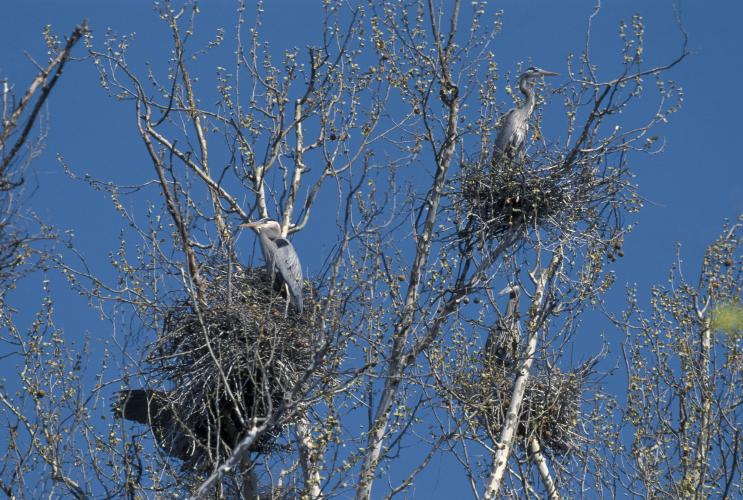You can recognize a heron as it flies overhead. Its long legs stretch out straight with its neck pulled back to form an “S.” Herons are often seen in flight, or when fishing. They’re not so commonly seen at the nest site.
Herons nest in colonies called “rookeries.” Rookeries are usually located in places isolated from disturbance. Herons often select mature sycamore trees along streams as rookery sites. A large tree may have many nests that can be used for decades. The largest nests are built toward the center of the crown where they are safest. Newer, flimsier nests are built at the edges. The bigger, older nests reach three or four feet across. They’re repaired and given a fresh lining each year as part of the birds’ courtship behavior. The female builds and maintains the nest, while the male brings her the materials. Each pair defends the area immediately surrounding their nest from other herons.
The pair produces one brood of three to six young each year. The adults disperse after the young fledge. The young stay on at the rookery and are the last to leave in mid to late July. Rookery activity begins about this time of year. See a slice of heron nesting life in the video below.
All About the Great Blue Heron
- Herons forage in shallow pools, edges of lakes and similar areas for aquatic prey including frogs, small fish and many other animals that can be swallowed.
- Great blue herons have a very large, slate-blue body, long legs, long, pointy bill and a slender, long neck. The head is white with a black, plumed eye line. The thighs are reddish or rusty and the lower legs dark. The bill is yellowish, and the pale breast feathers are long and plumelike. The voice is a low, harsh “gwock,” often heard in flight.
- As top predators, great blue herons check populations of many aquatic animals. Their eggs and chicks are frequently preyed upon by other predators, though not many animals hunt the adults.
- It is important to stay far back from breeding colonies, since the birds and their chicks can suffer fatal accidents in their haste to escape.
Learn more about the Great Blue Heron in MDC’s Field Guide.




Recent Posts
























